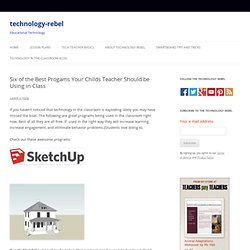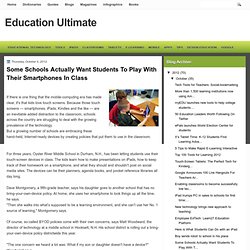

Technology Resources. List of 100 Amazing Video Websites for Educators. Six of the Best Progams Your Childs Teacher Should be Using in Class. If you haven’t noticed that technology in the classroom is exploding lately you may have missed the boat.

The following are great programs being used in the classroom right now. Best of all they are all free. If used in the right way they will increase learning, increase engagement, and eliminate behavior problems. (Students love doing it). Check out these awesome programs. Google SketchUp- One of my favorites. Download For free Here Audacity- 10 years ago people were paying hundreds of dollars for what you can do now with this amazing program for free. 13 Reasons Teachers Should Use Diigo. Home » Education, Social Media Written by Grace20 February 2012 The following is a guest post from Kay Cantwell, an Education Officer of Digital Learning at Brisbane Catholic Education in Brisbane Area, Australia. 13 Reasons Teachers Should Use Diigo Diigo stands for “Digest of Internet Information, Groups and Other stuff.”
It is a social bookmarking program that allows you to save your ‘favorites’ online, so that they can be accessible from any computer with an internet connection. So…here are 13 reasons every teacher should use Diigo: Diigo provides a free, efficient, effective and reliable way to save and organize your favorite websites, online articles, blog posts, images and other media found online. The free Diigo app can be downloaded from the iTunes store and you can be saving as you go. Open Education Resources -iCreate Open Source Textbooks. Web contents. Get Real! Learning. EDUCAUSE Homepage. Mission + History. Digital Promise is an independent, bipartisan 501(c)(3) nonprofit organization authorized by Congress to spur innovation in education.

Through its work with educators, technologists, researchers, and leading thinkers, Digital Promise supports comprehensive research and development to benefit lifelong learners and provide Americans with the knowledge and skills needed to compete in the global economy. In 1999, the Carnegie Corporation of New York partnered with the Century, Knight, MacArthur, and Open Society foundations to launch the Digital Promise Project – a project to recommend policies that would harness the breakthrough technologies of the Information Age to serve the public interest. To lead the effort, they recruited former FCC Chairman Newton N. Minow and former NBC News and PBS president Lawrence K. Grossman to serve as the project’s co-chairs. In 2001, Minow and Grossman published their recommendations in a book titled, “A Digital Gift to the Nation.”
Learning Registry. A Free Search Engine for Learning. Corporate Site. Web2 Developers. Canvas by Instructure. Many-to-One vs. One-to-Many: An Opinionated Guide to Educational Technology. Education is in some respects one of the most stagnant of all major industries.

A farmer from 150 years ago would not comprehend a modern farm. A factory worker from 150 years ago would not be able to function in a modern factory. But a professor from 150 years ago could walk into a classroom today and go to work without missing a beat. Is this about to change? Many entrepreneurs and commentators believe so. My evaluations are based on whether I view these technologies as supporting a model of education that is one-to-many or a model that is many-to-one. Don’t Believe the Hype One of the most-hyped ideas in the past year is MOOCs, or massive open online courses. Stanford's MOOCs appear to benefit two disparate groups of students, one nearby and one far away.
Well over 90 percent of the students who sign up for an MOOC do not benefit. We should not be surprised that MOOCs do not benefit most of those who try them. The attempt to achieve large scale in college courses is misguided. eSpark Learning eSpark Learning: Personalized learning on the iPad. The Digital Teacher's Network. Some Schools Actually Want Students To Play With Their Smartphones In Class. If there is one thing that the mobile-computing era has made clear, it's that kids love touch screens.

Because those touch screens — smartphones, iPads, Kindles and the like — are an inevitable added distraction to the classroom, schools across the country are struggling to deal with the growing prevalence of the technology. But a growing number of schools are embracing these hand-held, Internet-ready devices by creating policies that put them to use in the classroom. For three years, Oyster River Middle School in Durham, N.H., has been letting students use their touch-screen devices in class. The kids learn how to make presentations on iPads, how to keep track of their homework on a smartphone, and what they should and shouldn't post on social media sites.
The devices can be their planners, agenda books, and pocket reference libraries all day long. Dave Montgomery, a fifth-grade teacher, says his daughter goes to another school that has no bring-your-own-device policy. SOURCE > Sign Up for Cisco WebEx Meetings Basic or Premium. Piktochart Infographics. Project Based Learning - An Explanation and Model Rubrics.